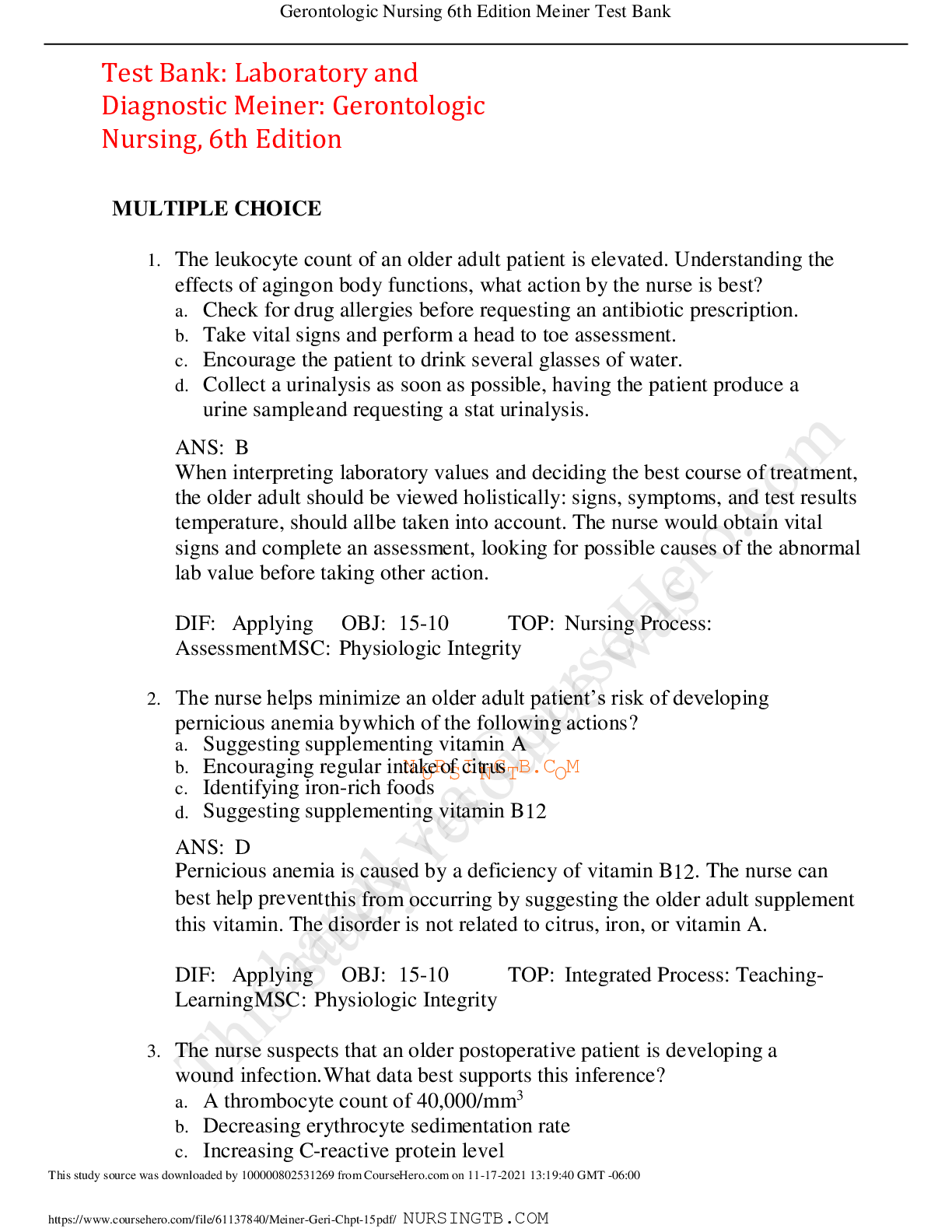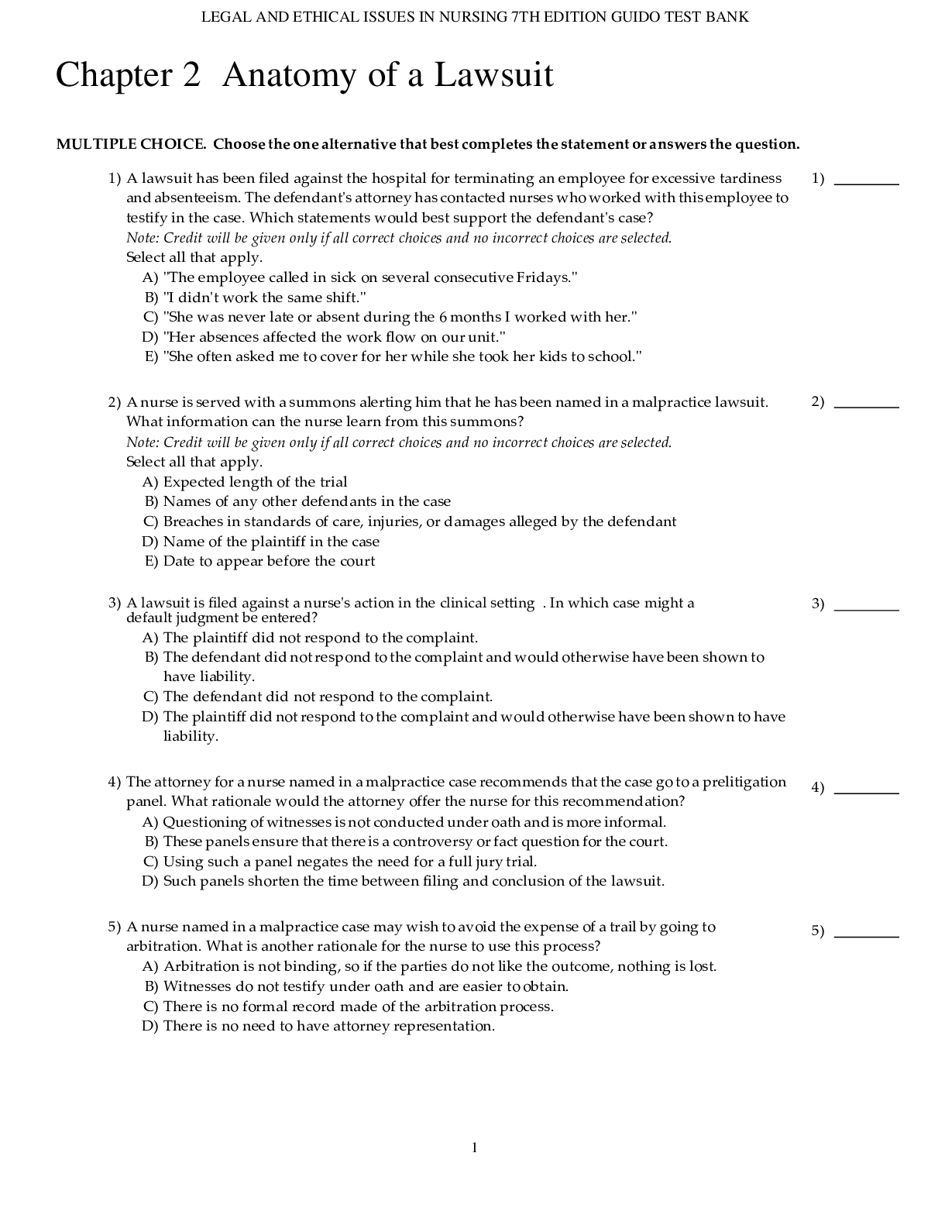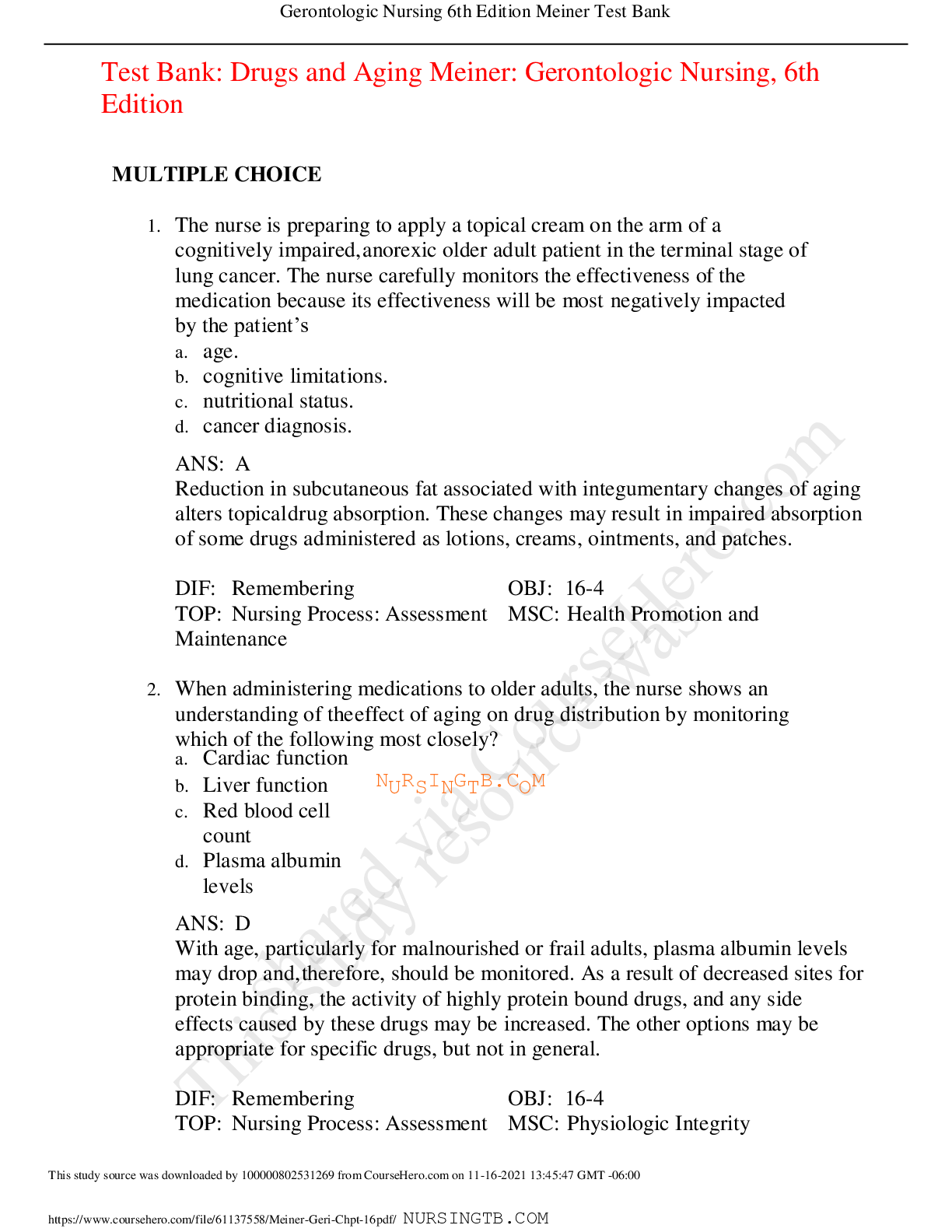*NURSING > TEST BANK > Test Bank: Legal and Ethical Issues Meiner: Gerontologic Nursing, 6th Edition,100% CORRECT (All)
Test Bank: Legal and Ethical Issues Meiner: Gerontologic Nursing, 6th Edition,100% CORRECT
Document Content and Description Below
Test Bank: Legal and Ethical Issues Meiner: Gerontologic Nursing, 6th Edition MULTIPLE CHOICE 1. A nurse caring for older adult patients shows an understanding of the implementation of standar... ds of care when a. dialing the telephone when the patient wants to call his daughter. b. requesting the patient’s favorite dessert on his birthday. c. closing the patient’s door when he is praying. d. reminding the patient to call for assistance before getting out of bed. ANS: D A standard of care is a guideline for nursing practice and establishes an expectation for the nurse to provide safe and appropriate care, such as reminding the patient to call for assistance before getting out of bed. Standards of care may be established on national or regional levels. Dialing the phone for the patient, closing the patient’s door, and requesting a special dessert are not actions that conform to standards of care. DIF: Applying OBJ: 3-1 TOP: Nursing Process: Implementation MSC: Safe and Effective Care Environment 2. A nurse new to gerontologic nursing asks the nurse manager to clarify how to handle a patient’s claim that she has been physically abused. The nurse manager responds most appropriately when stating a. “I’ll show you where yNouUcRanSfIinNdGthTisBs.taCteO’sMreporting requirements.” b. “As a nurse you are considered a ‘mandated reporter’ of elder abuse.” c. “As long as you are reasonably sure abuse has occurred, report it.” d. “You need to report any such claims directly to me.” ANS: A To be responsive to the legal obligation to report reasonably suspicious acts of abuse and because there is great variation among the states, nurses should determine the specific reporting requirements of their jurisdictions, including where reports and complaints are received and in what form they must be made. The statements that the nurse is a mandatory reporter and that abuse should be reported if suspected are true, but they do not help the nurse learn to handle the complaint. The manager may want to know about claims of abuse and it may be facility policy to report up the chain of command, but the nurse is responsible for filing the formal complaint. DIF: Applying OBJ: 3-8 TOP: Nursing Process: Implementation MSC: Safe and Effective Care Environment 3. An older adult resident of a long-term care nursing facility frequently attempts to get out of bed and is at risk of sustaining an injury. The nurse’s planned intervention to minimize the patient’s risk for injury is guided by which of the following? a. The patient’s right to self-determination and to be free to get out of bed. b. An understanding that nondrug interventions must be tried before medications. c. The knowledge that application of a vest restraint requires a physician’s order. d. The patient’s cognitive ability to understand and follow directions. ANS: B The drug use guidelines are based on the principles that certain problems can be handled with nondrug interventions and that such forms of treatment must be ruled out before drug therapy is initiated. The patient does have the right to self-determination, but the staff must ensure the patient’s safety. Vest restraints do require an order, but environmental measures must be tried before chemical or physical restraints. The patient’s cognitive abilities do not allow for unjustified physical or chemical restraints. DIF: Remembering OBJ: 3-7 TOP: Nursing Process: Implementation MSC: Safe and Effective Care Environment 4. During the state inspection of a skilled nursing facility, a surveyor notes suspicion that a particular nurse may not be providing the proper standard of care. The nurse manager informs the nurse to expect a. a review of the situation by the state board of nursing. b. termination of employment from the facility. c. mandatory remediation related to the suspect care issues. d. unannounced reevaluation of performance within the next 3 months. ANS: A In such cases, the surveyor may forward the record showing the relevant findings to the appropriate state agency or board for review of the nurse’s practice, requesting a determination of whether the nurse may have violated the state’s nurse practice act. Regulations do not specify that the nurse be terminated, have remediation, or have an unannounced reevaluation.NURSINGTB.COM DIF: Understanding OBJ: 3-1 TOP: Integrated Process: Communication and Documentation MSC: Safe and Effective Care Environment 5. An 87-year-old patient is unsure of the purpose of a living will. Which statement by the nurse is the best description? a. “It’s a legal document that Social Services can help you create.” b. “It designates a family member to make decisions if you become incompetent.” c. “It provides a written description of your wishes in the event you become terminally ill.” d. “It assures you won’t be subjected to treatments you don’t want.” ANS: C Living wills are intended to provide written expressions of a patient’s wishes regarding the use of medical treatments in the event of a terminal illness or condition. Social Services can help the resident complete a living will, but that does not describe its purpose. A Durable Power of Attorney designates a surrogate decision maker. The nurse should not use false reassurance by stating the document “assures” you won’t be subjected to unwanted treatments. DIF: Understanding OBJ: 3-9 TOP: Integrated Process: Teaching-Learning MSC: Safe and Effective Care Environment 6. The nurse is caring for a terminally ill older patient who has a living will that excludes pulmonary and cardiac resuscitation. The family expresses a concern that the patient may “change her mind.” The nurse best reassures the family by stating a. “The nursing staff will watch her very closely for any indication she has changed her mind.” b. “We will discuss her wishes with her regularly.” c. “She can change her mind about any provision in the document at any time.” d. “Your mother was very clear about her wishes when she signed the document.” ANS: A Advanced medical directive provisions appropriately provide that people can change their minds at any time and by any means. Nurses need to be alert to any indications from a patient. Based on the person’s medical condition, subtle signs such as a gesture or a nod of the head may be easily overlooked. The patient may or may not be able to discuss her condition. Stating that the mother was very clear in her wishes does not take into account the fact that patients can change their minds any time. DIF: Applying OBJ: 3-10 TOP: Integrated Process: Communication and Documentation MSC: Safe and Effective Care Environment 7. A patient residing in a long-term care facility has been experiencing restlessness and has often been found by nursing staff wandering in and out of other patients’ rooms during the night. The nurse views the patient’s PRN antipsychotic medication order as which of the following? NURSINGTB.COM a. An appropriate intervention to help assure the resident’s safety. b. An option to be used only when all other nondrug interventions prove ineffective. c. Inappropriate unless the physician is notified and approves its use. d. Not an option because it should not be used to manage behaviors of this type. ANS: D Reasons for the use of antipsychotic drugs do not include behaviors such as restlessness, insomnia, yelling or screaming, inability to manage the resident, or wandering. The staff must provide nondrug alternatives to help calm the patient. DIF: Analyzing OBJ: 3-7 TOP: Nursing Process: Planning MSC: Safe and Effective Care Environment 8. An alert but disoriented older patient lives with family members. The home health nurse, being aware of the role of patient advocate, recognizes the obligation to report possible patient abuse based on which of the following? a. A family member stating, “It’s hard being a caregiver.” b. Assessment showing bruises in the genital area. c. Observation of mild changes in orientation. d. Patient’s report of always being hungry. ANS: B Even when a patient exhibits disorientation, any report of mistreatment or neglect is to be considered reasonably suspicious and so should be reported. Bruises in the genital area raise suspicions of abuse. The family stating caregiving is hard does not mean that they don’t have enough support to cope. Mild changes in orientation may be expected in a disoriented patient. The patient who is always hungry should be followed up with a nutrition assessment, and this may or may not be a sign of abuse. DIF: Applying OBJ: 3-8 TOP: Nursing Process: Assessment MSC: Safe and Effective Care Environment 9. An older adult patient has been approached to participate in a research study. The nurse best advocates for the patient’s right to self-determination by doing which of the following? a. Evaluating the patient’s cognitive ability to understand the risks of the study. b. Determining what risks to the patient are involved. c. Discussing the importance of the study with the patient and family. d. Encouraging the patient to discuss the decision with trusted family or friends. ANS: A The right to self-determination has its basis in the doctrine of informed consent. Informed consent is the process by which competent individuals are provided with information that enables them to make a reasonable decision about any treatment or intervention that is to be performed on them. The other options do not address autonomy and self-determination. DIF: Applying OBJ: 3-7 TOP: Integrated Process: Communication and Documentation MSC: Safe and Effective Care Environment N R I G B.C M 10. A nurse responsible for the care of older adult patients shows the best understanding of the nursing standards of practice when basing nursing care on which of the following? a. Physician’s medical orders b. Stated requests of the individual patient c. Care that a responsible gerontologic nurse would provide d. Implementation of the nursing process ANS: C Nursing standards of practice are measured according to the expected level of professional practice of those in similar roles and clinical fields. Nursing care is not judged against the physician’s medical orders, stated requests of the patient, or implementation of the nursing process. DIF: Remembering OBJ: 3-1 TOP: Nursing Process: Implementation MSC: Safe and Effective Care Environment 11. A graduate nurse learns about the provisions of the Health Insurance Portability and Accountability Act (HIPAA), which include which of the following? a. Requires employers to offer health care insurance b. Regulates the amount employers can charge for insurance c. Mandates that employers provide specific benefits d. Helps maintain coverage when a person changes jobs ANS: D HIPAA has several provisions, one of which is that it helps people maintain health care insurance when they are changing jobs. The other statements are common misconceptions about HIPAA. DIF: Remembering OBJ: 3-5 TOP: Integrated Process: Teaching-Learning MSC: Safe and Effective Care Environment 12. The nurse manager in a long-term care facility reviews resident care plans at what interval? a. Quarterly b. Every 60 days c. Annually d. When changes occur ANS: A The resident care plan is routinely reviewed quarterly. DIF: Remembering OBJ: 3-1 TOP: Nursing Process: Assessment MSC: Safe and Effective Care Environment 13. The manager of a long-term care facility is evaluating patients’ use of drugs. The resident on which of the following medications would be allowed to continue taking medications to control behavior? a. On anxiolytics; now able to participate in group activities b. Given a benzodiazepine at night; roommate now sleeps well c. Given sedatives; eats 10N0%Rof ImeaGls iBf r.esCidenMt is fed d. Taking an antipsychotic; no longer wanders at night ANS: A Drugs should not be used to control behavior. If used to manage health conditions, the patient should show improvement. The patient who is now able to participate in group activities shows an increase in functional ability, so this medication is therapeutic for this patient. The other patients are given drugs to control behavior. DIF: Evaluating OBJ: 3-7 TOP: Nursing Process: Assessment MSC: Safe and Effective Care Environment 14. To meet current guidelines regarding incontinence in a long-term care facility, what action by the director of nursing is best? a. Assess residents for the ability to participate in a bladder training program. b. Take all residents to the toilet every 2 hours and after meals. c. Ensure all residents wear incontinence briefs, which are changed routinely. d. Ask physicians and other providers to prescribe medications for bladder control. ANS: A Urinary incontinence is a common problem that can lead to several complications. The extent to which residents participate in bladder training programs is an area of focus for facility inspectors. Some residents may need routine toileting, wearing briefs, and medications, but they should all be assessed for the ability to participate in bladder training. DIF: Applying OBJ: 3-4 TOP: Nursing Process: Assessment MSC: Physiologic Integrity: Reduction of Risk Potential 15. The director of nursing at a long-term care facility is getting ready for the annual inspection. What information guides the director? a. Visits cannot be unannounced. b. The director must be off site during the inspection. c. Nurses must answer questions from the inspectors. d. Results will be shared only through the mail. ANS: C Nurses present during inspections must answer questions posed by the inspectors. Visits can be unannounced. The director should be present during the survey. Results are shared during a conference, then a report is mailed later. DIF: Remembering OBJ: 3-4 TOP: Integrated Process: Communication and Documentation MSC: Safe and Effective Care Environment 16. The nursing student learns about the Patient Self-Determination Act. What is a key provision of this act? a. It establishes new rights for patients in medical facilities. b. It requires facilities to educate patients on their rights. c. It allows families to be approached for organ donation. d. It spells out the procedures for creating an advance directive. ANS: B NURSINGTB.COM The intent of this law is to ensure that patients are given information about the extent to which their rights are protected under state law. It does not establish new rights, is not related to organ donation, and does not specify procedures for advance directives. DIF: Remembering OBJ: 3-7 TOP: Integrated Process: Teaching-Learning MSC: Safe and Effective Care Environment MULTIPLE RESPONSE 1. To best address the patient’s right to self-determination, which of the following questions does the nurse ask at the time the patient is admitted to a nursing facility? (Select all that apply.) a. “Do you understand what a living will and durable power of attorney are?” b. “If you have already prepared an advance care directive, can you provide it now?” c. “Are you prepared to discuss your end-of-life choices with the nursing staff?” d. “Have you discussed your end-of-life choices with your family or designated surrogate?” e. “Would you like help with preparing a living will or a durable power of attorney?” ANS: A, B, D, E All the correct options address the patient’s right to make an informed decision regarding health care issues by using various advance directives. The patient does not need to discuss end-of-life choices with the staff in order to exercise the right to self-determination. DIF: Applying OBJ: 3-7 TOP: Integrated Process: Communication and Documentation MSC: Safe and Effective Care Environment 2. What provisions for nursing service are part of the Omnibus Budget Reconciliation Act (OBRA) as it pertains to long-term care facilities? (Select all that apply.) a. Resident assessments b. Annual screenings c. Minimum staffing d. Ensuring resident rights e. Registered nurse educational requirements ANS: A, B, C, D OBRA’s service requirements include resident assessments, annual screenings, minimum staffing requirements, and ensuring resident rights. Educational requirements for nurses are not part of this mandate. DIF: Remembering OBJ: 3-4 TOP: Nursing Process: Implementation MSC: Safe and Effective Care Environment 3. The director of nursing at a certified long-term care facility overhauls the nursing assistant training program to include which features? (Select all that apply.) a. 12 hours of classroom cNontRent I G B.C M b. Training in infection control measures c. Instruction on resident rights d. 6 hours of quarterly in-service education e. Education on safety measures ANS: B, C, E Requirements for a nursing assistant’s education include training in infection control and interpersonal skills, instruction on resident rights, and education on safety procedures. Nursing assistants must have classroom training before working with residents, but the amount of time is not specified. DIF: Applying OBJ: 3-3 TOP: Integrated Process: Teaching-Learning MSC: Safe and Effective Care Environment 4. The adult child of a long-term care facility resident receives a phone call from the director of nursing stating that resident has 30 days to move out of the home. Under what conditions can a facility require a resident to move? (Select all that apply.) a. Nonpayment for services received b. Needs exceeding what the facility can provide c. Stay is no longer required based on the resident’s medical condition d. Facility is going out of business e. Frequent disruptive behavior during the night ANS: A, B, C, D A facility can require a resident to leave in four situations: nonpayment for services, needs that exceed what the facility can provide, the patient’s medical condition no longer warrants long-term care, or the facility is going out of business. Being disruptive is not a cause for expelling a resident. DIF: Remembering OBJ: 3-3 TOP: Integrated Process: Communication and Documentation MSC: Safe and Effective Care Environment NURSINGTB.COM [Show More]
Last updated: 1 year ago
Preview 1 out of 15 pages
Instant download

Buy this document to get the full access instantly
Instant Download Access after purchase
Add to cartInstant download
Reviews( 0 )
Document information
Connected school, study & course
About the document
Uploaded On
Nov 17, 2021
Number of pages
15
Written in
Additional information
This document has been written for:
Uploaded
Nov 17, 2021
Downloads
0
Views
56
























